As early as the beginning of 2020, the French government announced that from 2022, new public buildings will have to use at least 501TPTP3T wood or other natural materials. The intention to increasingly use materials with a negative carbon footprint is also on the radar of other countries that want to reduce the amount of cement and steel used. The manufacture of these building materials releases a large amount of carbon dioxide into the atmosphere, posing a growing threat to the environment. Wood, a renewable material that consumes more carbon dioxide during the growing season than is removed during processing, appears to be the solution that policymakers are turning towards. What is important is that it is harvested sustainably, with the focus also on reforestation. Alongside wood, materials such as hemp and straw - previously seen as an extravagance - are being eyed with interest.
Other countries are also encouraging more wood for construction
It is not just France that is focusing on the use of wood in construction, but many other countries around the world. Germany, Sweden, Norway, Great Britain, Canada, New Zealand, Australia, Japan are just some of the countries that have already adopted local, regional or national policies on the use of wood in construction. For example, Finland provides government subsidies and funding for municipal buildings made of wood. The municipality of Hamburg, Germany, will contribute €0.8 for every kilogram of wood used in the construction or retrofitting of non-residential buildings, and in Wales there is the Home Grown Homes which aims to build 240 residential homes by 2024 using wood from local forests or from the UK, boosting the local rural economy.
These policies and projects aim to show to the public the technical and aesthetic possibilities of wood in order to arouse the interest of architects and builders and, last but not least, to change the perception of the private sector regarding the strength of wood construction. It is hoped that these buildings will become emblematic and thus the desire to build with wood will spread more and more deeply among the population. It is also intended to be an educational program so that, in addition to the use of wood as a building material, there will be an increased concern for its sustainable use.
Benefits of building with wood
Using wood in construction not only benefits the environment but also the people who live in those buildings. A United Nations Food and Agriculture Organization report on public policies encouraging the use of wood in construction highlights the advantages of this construction method. Here are some of them:
- Wood is a renewable natural material with a low environmental impact compared to other building materials,
- has a very good strength-to-weight ratio, as wooden constructions are much lighter at the same strength,
- is flexible and durable, wooden buildings performing very well in areas at high seismic risk,
- has very good thermal and electronic insulating properties,
- unlike steel, does not lose its load-bearing properties at very high temperatures,
- Building with wood is quicker and more efficient than with other materials,
- the waste resulting from the processing of wood into building components is entirely reusable,
- increase the comfort and well-being of those who live, work or learn in such buildings. Australian studies have shown that the presence of wood in office design increases employee concentration, productivity and satisfaction.

There is also a growing trend in Romania for the construction of residential houses or company headquarters in CLT or on wooden structure. George Buhnici - with his project Buhnici House - and Marius Șoflete with his numerous movies made on his YouTube channel.
Presenting the advantages of building with wood is one of our permanent concerns. In addition to the advantages related to the short construction time or the reduced cost of the foundation - thanks to the lower weight of wood for the same strength offered to the structure - we have often mentioned the following advantages energy efficiency of wood-frame houses. We will continue to introduce you to wooden houses and wooden house builders in the hope that more and more people who want to build in the future will choose wood.



































Add comment